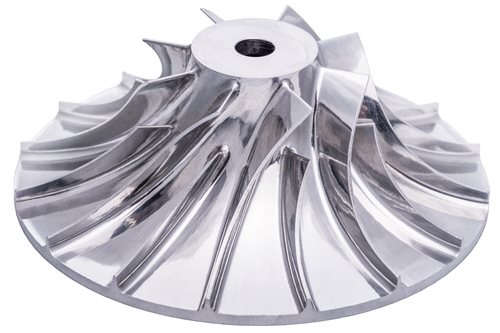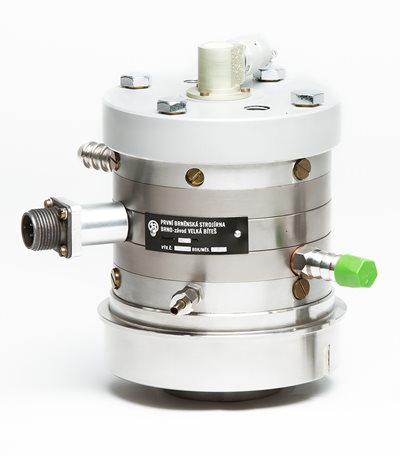Since the late '80s, PBS has supplied cryogenic turbines for the liquefaction of helium. Helium gas is liquefied in liquefiers and used for cooling, for example, for magnetic resonance imaging or scientific research. Evidence of the quality of cryogenic devices from PBS is that the HEXT 1.5 turbines manufactured between 1995 and 2003 are still in operation and the Aerospace Technology Division (ATD)supplies spare parts for them at regular intervals. Sales are growing again after years of decline and 14 turbines will be delivered this year.
Cryogenics is a physical discipline that deals with achieving very low temperatures and the appropriate behaviour of materials at these temperatures. Cryogenic temperatures are generally understood to mean temperatures ranging from -180 °C to -273.15 °C (absolute zero) but also different values may be seen.
The applications of cryogenics can be found in a number of industries, particularly in medicine (magnetic resonance, tissue and organ preservation, liquid gases), research (particle accelerators, laser research, superconductivity, superfluidity and low temperature research itself), space (liquefied gases serving as fuel, space research), and also in mechanical engineering (low-temperature stabilization of components, cooling of workpieces with liquid nitrogen), etc.
Helium has an exceptional position among cryogenic fluids
Helium has the lowest liquefaction temperature of all the substances. It is therefore used for cooling very specific equipment and in cases where extremely low temperatures are required.
The advantage of helium is that it is a non-reactive and non-explosive gas that dissipates heat very well. Although helium is the second most widespread element in the universe, its reserves are small on Earth and are rank it among the rare elements. It is contained in the atmosphere but only in negligible concentration. Greater helium content can be found in natural gas. Therefore, the production of helium is most often carried out through the separation from natural gas with a suitable composition. But there are not many such deposits in the world
The current production is almost unable to cover consumption. Helium and its production and sales are thus very expensive. Where it is not necessary to achieve such low temperatures, other, more accessible gases, commonly nitrogen, are used.

Compressor wheel
The 30-year History of Cryogenics in PBS
Cryogenics in ATD is most associated with helium. ATD has been developing cryogenic technology for more than 30 years, back when the production of helium expansion turbines started, for the liquefaction of helium for the company LINDE. Today, it is primarily the production of expansion turbines for various cryogenic gas liquefiers (helium) and so-called cold compressors and pumps for helium supply and storage systems.
Helium applications, whether gaseous or liquefied, require a very high technical level of the production processes, design and computational design and development as well as assembly and testing. PBS is one of the few companies in the world to independently provide all these stages of cryogenic device production all under one roof. ATD staff also ensure commissioning, training, warranty and post-warranty service.
Other gases used in cryogenics are less likely to be found in PBS. The demand for turbines and compressors for air, nitrogen, neon and argon are being addressed. A new neon turbine will also be supplied. To date, all cryogenic products of PBS have been used for inert gas applications but their design is basically applicable to other gases as well.
Recently, hydrogen applications have been seriously considered, as there is a noticeably growing interest in liquid hydrogen, especially for applications in automobiles. It is estimated that there is a significant increase in hydrogen consumption worldwide and PBS products could be used in this segment.
Sales are growing. ATD will supply 14 cryogenic turbines this year
The world's first cryogenic ATD product was the cryogenic turbine HEXT 0,5 designed for the Helia LKKA liquefier from LINDE (Germany, Switzerland). The co-operation was very successful, with a total of 270 turbines (135 liquefaction units) delivered between 1986 and 1992. The successor was the HEXT 1.5 turbine supplied to the LINDE TCF 10 liquefiers - 56 units were delivered in 1995-2003. An interesting and significant indicator of the quality of our production is that HEXT 1.5 turbines are still in operation and ATD supplies spare parts for this type of cryogenic turbines at regular intervals.
In 2003 we managed to realize another major step in turbine development - we started supplies of a new type of cryogenic turbines - HEXT 2 for HELIAL 1000 liquefiers for AirLiquide (France), another important global cryogenic company, and we delivered 36 units. The period from 2006 to 2016 brought a significant drop in the marketability of cryogenic machines. In total, only 10 turbines for research applications were delivered during this period. The main reason was the independence of the main customers, LINDE and AIR LIQUIDE in the production of turbines. In 2017 and 2018, however, we managed to increase sales to 8 units and for 2019 the supply of 14 turbines was signed.

The development of cryogenic turbines takes place in almost all areas
Complex manufacturing processes are improved and optimized, such as joining titanium and stainless steel parts by vacuum brazing or chemical nickel coating, and the use of electron beam welding is also expanding. All these new methods and procedures are validated and evaluated on several samples.
At the end of 2018, a new cryogenic turbine with a cooling performance of up to 3.5 kW was added to the portfolio (until then 2.5 kW was the maximum used). The grant project is also developing a more efficient cryogenic turbine with a cooling performance of up to 6 kW. Also new for 2019 is the design and production of a Neon cryogenic turbine with expansion into the wet steam area.
Cryogenic Compressors and Pumps
The origins of cryogenic compressors and pumps date back to the mid-1990s. The design concept was primarily developed in co-operation with LINDE for their liquid helium containers. However, we managed to provide a significant supply to the CERN research centre in co-operation with AIR LIQUIDE.
Compressors and pumps are currently being supplied as a subcontract - PBS supplies the compressor casing, the low-temperature part and the flow parts but the cryogenic drive is provided by the end customer. For these reasons, the development of our drive with aerodynamic gas bearings was launched last year which should ensure long-term trouble-free and maintenance-free operation of the entire compressor, and above all the possibility to offer a fully tested cryogenic compressor/pump with higher added value. A prototype of this drive with a maximum output of 3 kW should be ready by the end of next year.
A new workplace for low-temperature stabilization in liquid nitrogen
All the parts used in cryogenic device must meet the very demanding tightness requirements. Leak detection is performed by our staff using helium and a helium detector independently as they have all the relevant certified training.
A very critical area is welded and brazed joints. For early leak detection, it is necessary to always temperature stabilize them with liquid nitrogen, preferably immediately after welding or brazing. This stabilization is being carried out externally but in the near future, a workplace for low-temperature stabilization in liquid nitrogen will be prepared in ATD which will significantly speed up the production process of complex cryogenic components.
ZáIn cryogenic technology so-called cryogenic fluids with suitable properties for reaching low temperatures play an essential role. The most commonly used cryogenic fluids:
|
Gas
|
Liquefaction temperature at normal pressure [°C]
|
|
Metan
|
-161.5
|
|
Oxygen
|
-183
|
|
Argon
|
-186
|
|
Air
|
-193
|
|
Nitrogen
|
-196
|
|
Neon
|
-246
|
|
Hydrogen
|
-253
|
|
Helium
|
-268.9
|
|
Absolute zero
|
-273.15
|